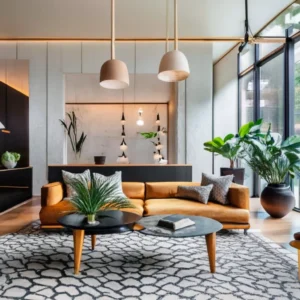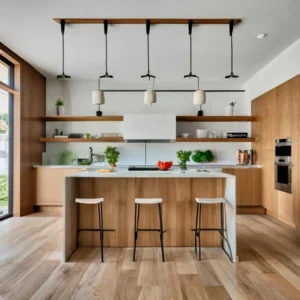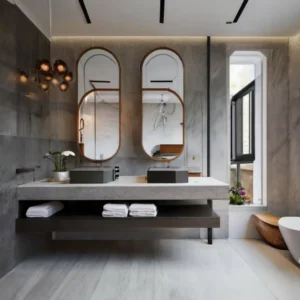Introduction
In a world where interior design is increasingly becoming an expression of individualism and personal comfort, minimalist industrial decor finds its place as a visual refuge, bringing with it structured simplicity and a sense of uncomplicated calm. This unique design approach combines the ruggedness of industrial style – thinking of raw materials, exposed lines and unfinished surfaces – with the pared-down aesthetic of minimalism, promoting spaces that are uncluttered, functional and, at the same time, deeply elegant.
At the heart of this design trend are two elements: lines and lights. Lines, with their ability to create order, direct attention and influence the perception of space, are fundamental in defining the structure of a room. Lights, in turn, are not only functional, but have the power to transform spaces, creating atmospheres, highlighting details and giving depth to a room. Together, lines and lights are powerful tools in harmonizing spaces, creating living areas that are both inviting and inspiring.
In this article, we’ll explore the art of minimalist industrial design, understanding its origins and core principles. We’ll dive into the essence of the effective use of lines and lighting, revealing how these elements can be orchestrated to transform and bring spaces to life. Through expert advice, case studies, and in-depth analysis, we’ll offer insights for those looking to embrace this aesthetic in their own homes or commercial spaces. Whether you’re a design enthusiast looking to revamp your space or a professional seeking new inspiration, this guide will serve as a path to unlocking the untapped potential of your spaces through minimalist industrial design.
Understanding Minimalist Industrial Decor
History and origins of the minimalist industrial style:
Minimalist industrial decor did not emerge as an intentional design trend, but as a practical and necessary response to the changing urban environment. In the 1960s and 1970s, many metropolitan areas began to see a migration of industries out of the cities, leaving behind large warehouses and factories. Artists and creative professionals, attracted by lower rents and vast open spaces, quickly occupied these abandoned spaces. They maintained the bare bones of these spaces, emphasizing structural simplicity and functionality.
The style we now call minimalist industrial grew out of these organic roots, a fusion of industrial pragmatism with a stripped-back artistic aesthetic. It is characterized by the preservation and exposure of the building’s construction elements, such as exposed brick, exposed electrical wiring and piping, and steel structures, combined with a simple, minimalist interior design.
Fundamental principles of minimalist industrial decoration:
- Simplicity and functionality: Design is not just about aesthetics, but also about creating livable and functional spaces. Each piece has a purpose, avoiding excess and clutter.
- Authenticity of materials: Minimalist industrial decor makes use of materials in their raw or minimally processed state – wood, concrete, metal, and glass are common. Beauty is found in the natural texture and simplicity of these materials.
- Space and Light: Large, open, well-lit spaces are the signature of the style, with an emphasis on natural light, helping to highlight the simplicity of the lines and the rawness of the materials.
Why this style remains relevant in the contemporary world:
The appeal of minimalist industrial decor remains strong in the contemporary world for several reasons. In an age of information overload and saturation, simplicity offers a haven for the senses. Furthermore, as we become more aware of the environmental impact of our choices, the authenticity and longevity of the materials used in this style of decor are particularly appealing.
This style also reflects an appreciation for the history and character of buildings, often incorporating the patina of time as part of the design. In a world that is constantly changing, there is a comforting beauty in the permanence and tangible history that these spaces represent. Furthermore, the flexibility and adaptability of minimalist industrial interiors make them exceptionally well-suited to modern workspaces and homes, fulfilling the need for spaces that are both versatile and stylistically timeless.
The Power of Lines in Industrial Decoration
Exploring the concept of lines in decoration and how they influence the perception of space:
Lines are more than physical boundaries; they guide the eye and influence perception, creating harmony, contrast and dynamism in a space. In the context of industrial design, lines are often inspired by the raw, functional structure of the space – think exposed beams, pipes, staircases and large windows. Vertically, lines can emphasize high ceilings, while horizontally they can widen or elongate a space. Diagonal lines, often found in staircases or mezzanines, add drama and movement. Each direction has the power to influence the feel of a space, making it more expansive, cozy, formal or relaxed.
Using lines in industrial decoration to create cohesive and dynamic spaces:
In a minimalist industrial space, using lines in your decor doesn’t mean adding unnecessary elements, but rather enhancing and working with existing structures. Here are some ways to do this effectively:
- Harmony and Continuity: Repeating lines through furniture and decor can unify a space, such as aligning wall art with the top of a sofa or following the lines of ceiling beams with furniture arrangement.
- Contrast and Focus: Opposing or intersecting lines create points of interest. For example, a rectangular dining table beneath a circular chandelier or pendant lights that break up the straight pattern of a kitchen.
- Movement: Curved or diagonal lines can break up monotony, guiding the eye through a space and creating flow, such as a spiral staircase that becomes a focal point or rugs arranged to suggest direction.
Case study: Environments transformed through the strategic use of lines:
To illustrate the power of lines in industrial design, consider an urban loft. Originally, the space featured exposed piping and a haphazard arrangement of columns. After an interior designer intervened, every linear element was intentionally utilized.
First, the horizontal lines of the pipes were complemented with floating shelves on the same level, uniting the room and creating a sense of order. The columns, once a visual impediment, were integrated into the aesthetic through vertical artwork that echoed their lines, establishing visual continuity. Finally, the inclusion of a rug with angular geometric patterns introduced diagonal lines that drew the eye to the conversation-style sofa, creating an inviting focal point.
This readjustment not only harmonized the space but also highlighted the aesthetic beauty of the industrial features, demonstrating how the clever use of lines can transform an environment from cluttered to designer.
Influence of Lights in Creating Environments
The importance of lighting in minimalist industrial interior design:
Lighting is one of the most powerful elements in interior design, especially in the minimalist industrial context. It not only enhances the functional beauty of raw materials and structural lines, but also creates the atmosphere of the space. In a style that refrains from decorative excesses, light takes on the main role in presenting the space, highlighting its purity and authenticity, and offsetting the potential coldness that concrete and metal can convey.
Types of lighting to complement minimalist decor: natural, accent, ambient and functional light:
- Natural Light: Taking advantage of natural light is essential in minimalist industrial design, as it softens the harshness of materials and brings vitality to the space. Large windows, skylights and glass partitions help to maximize the entry of sunlight during the day.
- Accent Lighting: This is used to focus attention on specific points, such as a piece of art or a textured wall. This can be achieved by using directional fixtures or track lights.
- Ambient Lighting: This is the main light in the space, ensuring an even and comfortable distribution of light. In industrial spaces, this is often achieved through industrial-style pendant lights or recessed lights that complement the minimalist aesthetic.
- Functional Lighting: This refers to light directed at work areas, such as desks or kitchen countertops. Desk lamps, under-cabinet lighting, and adjustable floor lamps are examples that combine functionality with design.
Practical tips for choosing the right lighting and how it can make a space feel bigger, warmer or more welcoming:
- Larger Space: To make a space feel larger, choose lighting that creates visual lines and directs the eye across the room. Track lights or pendants in a row can visually extend a space. Strategically placed mirrors can reflect light and add depth.
- Warmer Space: Natural materials, such as wood or fabric, can soften the look of light fixtures. Warmer-toned lights or filament bulbs can add a cozy glow, softening the cold industrial vibe.
- Cozier Space: Vary your light sources to add complexity and comfort. A mix of soft ambient lighting, accent lights for unique textures or features, and functional lighting for reading or other activities creates a welcoming feel.
In all cases, flexibility is key. Choose lighting options that allow for adjustments in direction and intensity, so you can adapt the atmosphere of the space to meet changing day-to-day needs.
Harmonizing Spaces with Minimalist Industrial Decor
Integrating lines and lights for a cohesive aesthetic:
True harmony in a minimalist industrial space comes from the thoughtful coexistence of structure and light. Lines and light should work together, guiding the eye and highlighting essential elements without overwhelming the senses. One effective way to achieve this is to allow the lines of the space to dictate the placement of lighting. For example, track lights could follow the line of ceiling beams, or floor lamps could align with the vertical lines of a window or tall bookshelf. Lighting should enhance, not overshadow, the structural qualities of the space, complementing the rustic shapes and surfaces with soft shadows and strategic highlights.
Tips for balancing functionality and design when harmonizing spaces:
Functionality is the soul of minimalist industrial decor, and every design choice should serve a practical purpose as well as an aesthetic one. Here are some tips for maintaining this balance:
- Select furniture that is both statement pieces and functional, such as a sturdy metal coffee table with storage shelves or sofas with clean lines that also offer exceptional comfort.
- Keep the color palette tight to avoid visual clutter; let texture and shape take center stage. Neutral tones can be enhanced with key accessories, such as colorful pillows or vibrant art, which can be swapped out as needed for a quick refresh.
- Use room dividers strategically to define functional areas without compromising the feeling of open space. Open shelving or glass dividers maintain visual lightness while segmenting the space in a practical way.
Avoiding excess: the key to maintaining simplicity and visual impact:
Minimalist industrial decor lives by the principle “less is more.” Here’s how to stay true to that philosophy:
- Before adding a new element, consider its need and impact. If it doesn’t serve a functional or aesthetic purpose, it’s likely superfluous.
- Let some space “breathe”; not every area needs to be filled with furniture or decorations. Negative spaces contribute to a sense of calm and order and can be just as effective as decorated areas.
- Choose quality over quantity. Choose fewer pieces, but invest in items that offer durability and visual impact, valuing the authenticity of the materials and the excellence of the design.
By avoiding excess, you maintain a calm, uncomplicated atmosphere that invites reflection and relaxation, enhancing the raw, unpretentious beauty of the minimalist industrial style.
Design Advice
Design insights and recommendations:
Importance of authenticity in materials, integrity of forms and the art of restraint. Here are some insights we share:
- Find beauty in simplicity and functionality. We suggest choosing pieces that tell a story, whether it’s the patina of a metal table or the raw texture of an exposed brick wall.
- Let the space speak for itself. This means minimizing clutter and letting the architecture, light and materials create the space.
- Lighting is the soul of a space, the correct choice of lighting fixtures can dramatize or soften the austerity of an industrial environment, depending on the design intention.
Common mistakes in minimalist industrial decor and how to avoid them:
Even with the apparent simplicity of the style, there are pitfalls that design enthusiasts can fall into. Some of the most common mistakes include:
- Over-Austerity: A space should not feel cold or uninhabitable. Avoid this by introducing warm textures, plants, and elements with warmer or earthy colors.
- Confusing Minimalism with Monotony: Minimalism means less, but each piece should have impact and presence. Contrast is vital; mix materials, incorporate statement pieces and play with different types of lighting.
- Neglecting Comfort: Functionality goes beyond practicality; it must also meet the needs of comfort. Choose furniture that combines style and comfort, and create points of interest that make the space feel welcoming.
Transforming different areas of the home or office with minimalist industrial decor:
Minimalist industrial decor can be adapted to a variety of spaces, each with its own unique requirements.
- Living Room: Opt for a statement sofa with clean lines, complemented by warm, welcoming lighting. Add a textured rug to define the space and add plants for a burst of life.
- Kitchen: Keep cabinets and shelves clean and functional. Accent lighting over the countertop or kitchen island is not only practical, but also aesthetic. Add metal or wood bar stools for an authentic touch.
- Office: Functionality is key here. Choose a sturdy desk with clean lines and add smart storage. Use adjustable light fixtures and don’t forget to incorporate green elements, like plants, which can improve concentration.
- Bathroom: Opt for simple fixtures and a monochromatic color scheme. Concrete or steel can be offset with fluffy towels and soft lighting to create a spa-like ambiance.
In each area, the goal is to preserve simplicity without sacrificing personality or comfort, creating environments that are both reflective and welcoming.
Lessons learned and results achieved:
These case studies demonstrate the versatility and effectiveness of minimalist industrial design. Among the lessons learned, we highlight the importance of:
- Respect Existing Architecture: In each example, original elements of the building were not only preserved but highlighted, showing that the harmonious integration of new with old can deliver impressive aesthetic and functional results.
- Customize Light Usage: The lighting was not standardized, but rather adapted to the specific needs of each space, demonstrating that understanding the functional and atmospheric role of light can completely transform an environment.
- Balancing Form and Function: The spaces are not only visually stunning, but also fully habitable and usable, emphasizing that true design is not just what you see, but how you live in the space created.
These projects, therefore, not only inspire with their beauty, but also serve as a reference for how the minimalist industrial style can be cleverly and creatively adapted to suit a variety of space needs.
Conclusion:
As we explore the depth and adaptability of minimalist industrial decor in this article, we delve into a world where simplicity meets the raw and the refined, creating spaces that are not only aesthetically pleasing, but also deeply functional and inviting. Looking back at the insights and concepts discussed, it’s clear that this style, which celebrates the intersection of old and new, raw and finished, has a lot to offer in terms of interior design.
A crucial point we discussed is the significant role that lines and lights play in creating spaces that communicate calm, clarity, and focus. Lines, with their direction and boundaries, help guide the eye and perceive the environment, while the right lighting can completely change the atmosphere of a space, influencing not only mood but also perception of size and comfort.
Reflecting on the inspiring projects and advice shared, we see that minimalist industrial decor offers a spectrum of opportunities to reinvent and harmonize our spaces. It’s not just about following trends, but about understanding the fundamental principles that underpin this style: an appreciation for the history and authenticity of materials, a commitment to functionality, and a thoughtful and intentional approach to aesthetics.
So, we invite you, our readers, to experiment with minimalist industrial decor in your own spaces. Whether it’s choosing an industrial-style statement piece, reimagining your lighting, or even stripping your space back to reveal its raw, authentic essence, every step toward this style can be deeply rewarding.




